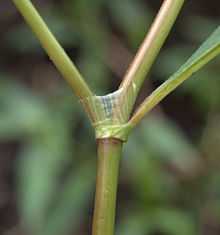Persicaria maculosa
| Persicaria maculosa | |
|---|---|
 | |
| Scientific classification | |
| Kingdom: | Plantae |
| (unranked): | Angiosperms |
| (unranked): | Eudicots |
| (unranked): | Core eudicots |
| Order: | Caryophyllales |
| Family: | Polygonaceae |
| Genus: | Persicaria |
| Species: | P. maculosa |
| Binomial name | |
| Persicaria maculosa Gray | |
Persicaria maculosa (syn. Polygonum persicaria) is an annual plant in the knotweed family, Polygonaceae. Common names include lady's thumb,[1] spotted lady's thumb, Jesusplant, and redshank.[2] It is native to Eurasia and present as an introduced and invasive species in North America, where it was first noted in the Great Lakes region in 1843.[3]
Taxonomy
There are three varieties:
- Polygonum persicaria var. angustifolium Beckh.
- Polygonum persicaria var. persicaria
- Polygonum persicaria var. ruderale (Salisb.) Meisn.
Synonyms include P. maculata, P. persicaria, P. ruderalis, P. ruderalis, P. vulgaris, P. dubium, P. fusiforme, P. minus and P. puritanorum.
Description
Redshank is an annual herb with an erect rather floppy stem with swollen joints, growing to a height of 10 to 60 cm (4 to 24 in). The leaves are alternate and almost stalkless. The leaf blades often have a brown or black spot in the centre and are narrowly ovate and have entire margins. Each leaf base has stipules which are fused into a stem-enclosing sheath that is loose and fringed with long hairs at the upper end. The inflorescence is a dense spike. The perianth of each tiny pink flower consists of four or five lobes, fused near the base. There are six stamens, two fused carpels and two styles. The fruit is a shiny black, three-edged achene. This plant flowers from July to September.[4]
Distribution and habitat
It is native to Europe and Asia, where it can be mistaken for Polygonum minus. The latter has narrower leaves, usually less than 1 cm wide. It has been introduced to North America and is naturalised throughout the mainland continent,[5] growing along roadsides, riverbanks, and on fallow ground. In the USA, it is very similar to Pennsylvania smartweed, but redshank has a fringe of hairs at the top of the ochrea, something which Pennsylvania smartweed lacks.
Ecology
In the United Kingdom, this plant is a weed, without natural habitat, and always associated with human activity. [6] It likes moist soils, particularly reach ones, and acid peaty loams.[7] It does not like lime, and liming is cited as a means to fight it.[8] [9]
Cultivation and uses
This plant contains persicarin and tannins. In medicine, Redshank is used against diarrhoea and infections. The leaves and young shoots may be eaten as a palatable and nutritious leaf vegetable. It is often seen as a weed and rarely cultivated. A yellow dye can be produced from this plant with alum used as a mordant.
References
- ↑ "Polygonum persicaria". Integrated Taxonomic Information System. Retrieved 15 October 2007.
- ↑ Persicaria maculosa. Germplasm Resources Information Network (GRIN).
- ↑ "List of invasive species in the Great Lakes Great Lakes United / Union Saint-Laurent Grands Lacs". Retrieved 2009-02-07.
- ↑ "Redshank: Persicaria maculosa". NatureGate. Retrieved 2013-12-30.
- ↑ USDA
- ↑ Simmonds, N W (1945). "Biologycal flora of the British Isles. Polygonum L.". Journal of Ecology (33): 117–143.
- ↑ Long, H. C. (1938). "Weeds of arable land". MAFF Bulletin (108).
- ↑ Fenton, E. W. (1931). "Poisonous and milk-staining plants". Pamphlet of Edinbourgh and East of Scotland College of Agriculture. New series (4): 7–31.
- ↑ Bond, W. "The biology and non chemical control of Redshank (Persicaria maculosa Gray)". HDRA. Retrieved 13 October 2013.
| Wikiversity has bloom time data for Persicaria maculosa on the Bloom Clock |
| Wikispecies has information related to: Persicaria maculosa |
